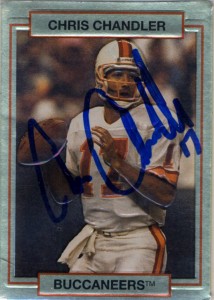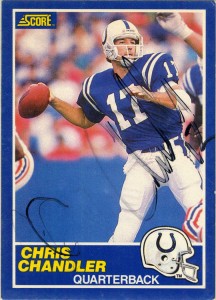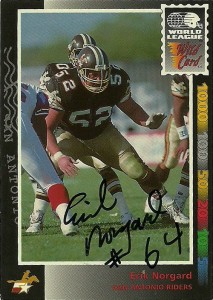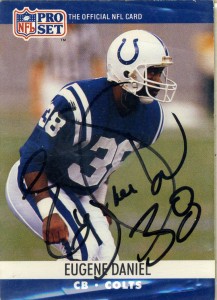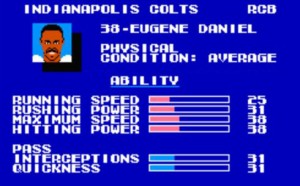Cards: Action Packed Rookies 1990, Score 1989
Acquired: In Person, CGA Youth Golf Tournament 1993, Houston Oilers Training Camp 1995
To label Chris Chandler a jouneyman quarterback would be both an accurate assessment but bring the wrong connotation about a player who enjoyed a renassaince over his career once he had shrugged off the entrapments of cellar dweller football. Probably the greatest problem Chandler experienced over his career was a severe issue with durability and up and down play. Despite these issues, Chris was able to hang around for 17 seasons and posted a 67-85 record as a starter.
Originally the quarterback of the future for the Colts when they drafted him in the 3rd round of the 1988 draft, Chris was buried under the depth chart and by 1990 (with the arrival of Jeff George) sent packing to the Tampa Bay Buccaneers who were looking for a new direction after the Vinny Testaverde experiment ended. The Bucs would get taken by the Colts for a 1st round choice for him and name Chris starter immediately- but his tenure in Tampa was largely forgettable, lasting 1 and 1/2 seasons before he was cut. Chandler would then bounce around the league as a backup, for both the Cardinals and the then Los Angeles Rams.
In 1995 Chris would get the starting nod with the vagabond Houston Oilers under Jeff Fisher. He was brought in as insurance by the team and to tutor the young quarterback of the future Steve McNair. Chandler played well enough to keep the starting job that year under wraps, (even posting a perfect passing rating in one game against the Bengals,) but by 1996 surrendered the job to 1st round draft choice Steve McNair. It was the right move by the team, and ended up being the right move for Chandler- who would be traded to the Atlanta Falcons for a reasonable 4th round pick.
Chris’ rebirth would continue with the Atlanta Falcons in the most improbable way under head coach Dan Reeves. Amazingly in 1997 and the following year Chandler would post his best seasons, go to the Pro Bowl and lead the Atlanta Falcons to their only Super Bowl appearance in 1998, but after failing to reach the big dance- again frustration mounted, and the Falcons drafted Michael Vick. Chandler would again find himself in the same situation he was with on the Oilers- as a lame duck. This would essentially end Chris’ time with the Falcons by 2002 and he would be left exposed for the Houston Texans Expansion draft however not be selected. He’d sign with the Bears that season and be back up for 2 more years, before playing briefly for the St. Louis Rams and then retire in 2004.
An avid golfer I got Chris’ autograph at the CGA Youth Golf Tournament back in 1993, and then again at training camp when he played for the Oilers in 1995. Another one of these football players- turned golfers Chandler is apparently quite good on the links. He has also recently taken up coaching as well to pass the time. Among Chandler’s NFL legacies is the only player to throw for a perfect passer rating in a game and a 0 in another, started for a record 8 NFL teams and threw a touchdown for a record 7 NFL franchises. Certainly Chris defined and deserves the NFL journeyman label- but with it he gave a level of respect and dignity to it.
G/Gs 180/152 Att 4005 Comp 2328 Yds 28484 Pct 58.1 Td 170 Int 146 Rat 79.1
